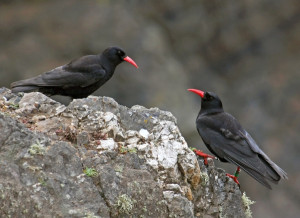Produced jointly by RSPB, BTO, Natural Resource Wales (NRW) and the Welsh Ornithological Society (WOS) , this report provides a current overview of the state of breeding and wintering bird populations in Wales, as well as information about recent conservation initiatives.
The State of Birds in Wales 2018 was published on 6 December 2018.
This report includes an update of the latest Wales BBS trends for terrestrial and freshwater species, as well as the latest Wales WeBS trends for wintering waders, wildfowl and other waterbirds. Notable among the BBS results are the positive trajectories of Wales urban populations of House Sparrow, Feral Pigeon and Collared Dove relative to in the UK overall. Welsh House Martins are holding their own but Starlings are in steep decline.
The Wales wild bird indicator, based on BBS results, tracks the declines since 1994 in both lowland and upland farmland bird species, as well as an upturn in woodland bird populations, the latter most notable over the past seven years.
Patterns of change
A special feature of this report is a section called ‘Patterns of change in Welsh birds’ in which key Wales-specific outputs of the 2007-11 Bird Atlas (Balmer et al. 2103) are highlighted. These include measures of the importance of Wales in supporting the UK breeding populations of Chough (76%), Pied Flycatcher (69%), Redstart (47%) and Honey Buzzard (47%) as well as significant proportions of the UK wintering populations of coastal species such Common Scoter and Guillemot as well as rarer winter visitors such as Brambling and Great Grey Shrike.

The report also includes measures of long term changes (ca 40 years) in breeding range since the first breeding bird atlas. Farmland birds have fared worse, with half of all farmland species having suffered loss of breeding range, by over 50% in the case of Grey Partridge, Yellow Wagtail, Turtle Dove and Tree Sparrow. Birds of farmed uplands such as Curlew, Golden Plover, Black Grouse and Ring Ouzel also showed marked range loss. In contrast, most birds of wetlands had increased in range and new colonists to Welsh wetlands include Bearded Tit, Little Egret, Avocet and Mediterranean Gull. Birds of woodland and heaths had mixed fortunes with declines in the range of woodland specialists such as Willow Tit and Lesser Spotted Woodpecker balanced by increases in species that favour forest plantations such as Hobby, Nightjar, Siskins and Crossbills.
Another group of species that has increased its range in Wales are the non-natives, in particular Canada Goose, naturalised Greylag Goose, Mandarin Duck, Muscovy Duck, Black Swan and Ring-necked Parakeet.
Also included in the report are accounts of conservation projects to investigate movements in recently fledged Hen Harriers, studies of diet and habitat use by Hawfinch, migration routes of Greenland White-fronted Geese and research on the movements and habitat requirements of Curlew, one of Wales most vulnerable species.
This report should be referenced as Bladwell, S., Noble, D.G., Taylor, R., Cryer, J., Galliford, H., Hayhow, D.B., Kirby, W., Smith, D., Vanstine, A. & Wotton, S.R. 2018. The state of birds in Wales 2018. The RSPB, BTO, NRW and WOS. RSPB Cymru, Cardiff
No comments:
Post a Comment